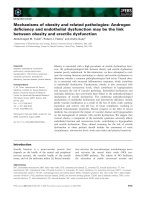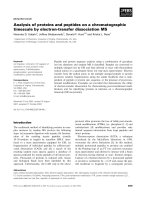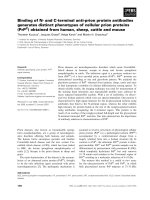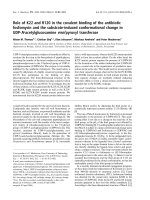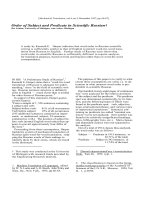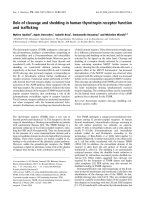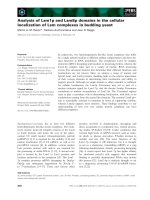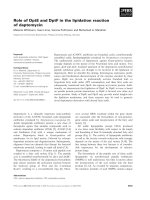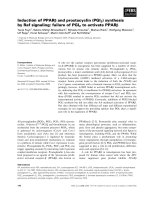Báo cáo khoa học: Epoxidation of benzo[a]pyrene-7,8-dihydrodiol by human CYP1A1 in reconstituted membranes Effects of charge and nonbilayer phase propensity of the membrane pot
Bạn đang xem bản rút gọn của tài liệu. Xem và tải ngay bản đầy đủ của tài liệu tại đây (185.73 KB, 7 trang )
PRIORITY PAPER
Epoxidation of benzo[
a
]pyrene-7,8-dihydrodiol by human CYP1A1
in reconstituted membranes
Effects of charge and nonbilayer phase propensity of the membrane
Pyotr Kisselev
1,
*, Dieter Schwarz
1
, Karl-Ludwig Platt
2
, Wolf-Hagen Schunck
3
and Ivar Roots
1
1
Institute of Clinical Pharmacology, University Medical Centrum Charite
´
, Humboldt University of Berlin, Germany;
2
Institute of Toxicology, University of Mainz, Germany;
3
Max Delbrueck Centrum for Molecular Medicine, Berlin, Germany
Human cytochrome P 4501A1 (CYP1A1) is one of the key
enzymes in the bioactivation of environmental pollutants
such as benzo[a]pyrene (B[a]P) and other polycyclic aro-
matic hydrocarbo ns. To ev aluate the effect of membrane
properties a nd distinct phospholipids o n t he activity of
human CYP1A1 purified insect cell-expressed human
CYP1A1 and of human NADPH-P450 reductase were
reconstituted into phospholipid vesicle membranes. Con-
version rates of up to 36 pmolÆmin
)1
Æpmol
)1
CYP1A1 of the
enantiomeric promutagens (–)- and (+)-trans-7,8-dihy-
droxy-7,8-dihydro-B[a]P (7,8-diol) to the genotoxic diolep-
oxides were achieved. The highest rates were obtained when
negatively charged lipids such as phosphatidylserine and
phosphatidylinositol and/or nonbilayer phospholipids such
as phosphatidylethanolamine were present in the membrane
together with neutral lipids. Both V
max
and K
m
values w ere
changed. This suggests a rather complex mechanism of
stimulation which might include altered substrate binding as
well as more effective interaction between CYP1A1 and
NADPH-P450 reductase. Furthermore, the ratio of r-7,t-8 -
dihydroxy-t-9,10-epoxy-7,8,9,10-tetrahydro-B[a]P (DE2) to
r-7,t-8-dihydroxy-c-9,10-epoxy-7,8,9,10-tetrahydro-B[a]P
(DE1) f ormed f rom (–)-7,8-diol was significantly increased
by the introduction of anionic lipids, but not by that of
nonbilayer lipids. Thus, c harged lipids affect the stereose-
lectivity of the epoxidation b y leading to the formation of a
larger amount of the ultimate mutagen DE2 than of DE1,
which is far less carcinogenic. These data suggest that
membrane properties such as negative charge and nonbi-
layer phase propensity are important for the efficiency and
selectivity o f e nzymatic function of human CYP1A1.
Keywords: human cytochrome P4501A1; vesicle r econstitu-
tion; epoxidation; benzo[a]pyren e; benzo[ a]pyrene-7, 8-diol.
Human cytochrome P 4501A1 (CYP1A1) is one of the key
enzymes in the bioactivation of environmental pollutants.
Benzo[a]pyrene (B[a]P) and other polycyclic aromatic hy-
drocarbons acquire their mutagenic and carcinogenic prop-
erties by its a ction. The first s tep of a ctivation catalyzed by
CYP1A1 is the formation of 7R,8S-epoxy-7,8-dihydro-
B[a]P. This is transformed via r egioselective hydrolysis by
microsomal epoxide h ydrolase to (–)-7 R,8R-dihydroxy-7,8-
dihydrobenzo[a]pyrene ((–)-7,8-diol) and then metabolized
by CYP1A1 to the ultimately genotoxic r-7,t-8-dihydroxy-t-
9,10-epoxy-7,8,9,10-tetrahydro-B[a]P (so-c alled diolepox-
ide-2 or antidiolepoxide, DE2) [1–3]. The last reaction
appeared to be highly stereoselective as no or much less of the
less carcinogenic r-7,t-8-dihydroxy-c-9,10-epoxy-7,8,9,10-
tetrahydo-B[a]P (diolepoxide-1 or sy n-diolepoxid e, DE1)
was p roduced from (–)-7,8-diol [4,5]. Racemic (+/–)-7,8-diol
is mainly converted by human CYP1A1 to the DE2 [6,7].
CYP1A1-dependent activity can be reconstituted by
mixing the basic components of the monooxygenase system,
i.e. purified CYP1A1, NADPH-cytochrome P450 reductase,
which transfers elect rons f rom NA DPH t o P 450, and
dilaurylglycerophosphocholine (Lau
2
PtdCho) [8–10]. H ow-
ever, this micellar system is not appropriate for studying the
interactions between the components o f the system as some
of its properties are unlike those of the endoplasmic
reticulum m embrane, t he n atural enviro nment o f t he
microsomal monooxygenase system. This membrane is a
bilayer, and it is highly p robable that CYP1A1 and
NADPH-cytochrome P450 reductase exhibit other impor-
tant protein–lipid and protein–protein interactions there.
Indeed, reconstitution systems using bilayer vesicles yielded
higher rates of activity w ith rabbit liver CYP3A6 and
CYP2B4 [11,12] and with human CYP3A4 [13] t han micellar
Correspondence to D. Schwarz, Charite
´
, Humboldt University of
Berlin, c/o M ax-Delbrueck-Centrum, Robert Roessle Str. 10, D-13125
Berlin, Germany.
Fax: + 4 9 30 9406 3329, Tel.: + 49 3 0 9406 3711,
E-mail:
Abbreviations: P450, human cytochrome P4501A1 (CYP1A1);
Lau
2
PtdCho, dilaurylglycerophosphocholine; Ole
2
PtdCho, diol-
eoylglycerophosphocholine; Ole
2
PtdPEtn, dioleoylglycerophospho-
ethanolamine; PtdCho, phosphatidylcholine; PtdEtn,
phosphatidylethanolamine; Ela
2
PtdEtn, dielaidoylglycerophospho-
ethanolamine; PtdSer, phosphatidylserine; PtdIns, phosphatidylinos-
itol; P A, phosphatidic acid; B[a]P, benzo[a]pyrene; DE2, diolepoxide 2
(r-7,t-8-dihydroxy-t-9,10-epoxy-7,8,9,10-tetrahydro-B[a]P); DE1,
diolepoxide 1 (r-7,t-8-dihydroxy-c-9,10-epoxy-7,8,9,10-tetrahydro-
B[a]P); (+/–)-7,8-diol, (+/–)-trans-7,8-dihydroxy-7,8-dihydro-B[a]P].
*Present address: Institute of Bioorganic Chemistry, Academy
of Sciences of Belarus, Minsk, Belarus.
(Received 21 December 2 001, revised 14 February 2002, a ccepted 20
February 2 002)
Eur. J. Biochem. 269, 1799–1805 (2002) Ó FEBS 2002 doi:10.1046/j.1432-1033.2002.02848.x
Lau
2
PtdCho sys tems. There is s ome evidence that the
membrane charge is an important determinant for P450-
dependent activity [14–16]. Furthermore, the presence of
specific lipids of the nonbilayer class was found to be essential
for optimal activity of microsomal and mitochondrial P450s.
For instance, rabbit liver CYP2B4 requires phosphatidy-
lethanolamine ( PtdEtn) [ 12], and bovine a drenal CYP11A1
requires cardiolipin, PtdEtn or branched phosphatidylcho-
line (PtdCho) [17–19] for optimal activity as well as for
membrane reconstitution. Reconstitution of purified human
CYP1A1 using phospholipid vesicles with CYP1A1 and
P450-reductase incorporated into the membrane has not
been reported to our knowledge. There are no data available
which demonstrate how lipids influence the ster eo- and/or
regioselectivity of a P 450-catalyzed r eaction. We investigated
whether human CYP1A1 could be reconstituted into vesicle
membranes effectively enough to study the e ffects of mem-
brane properties and/or distinct phospholipid s on C YP1A1
activity. We c haracterized the i mpact o f negatively c harged
and nonbilayer lipids on CYP1A1-dependent stereoselective
epoxidation by using both (optically pure) enantiomeric
promutagens (+)-7S,8S-dihydroxy-7,8-dihydrobenzo[a]py-
rene ((+)-7,8-diol) and (–)-7 R,8R-dihydroxy-7,8-dihydro-
benzo[a]pyrene ((–)-7,8-diol), as substrates.
EXPERIMENTAL PROCEDURES
Materials
Ole
2
PtdCho, Ole
2
PtdEtn, E la
2
PtdEtn, a nd PtdSer were
bought from Avanti Polar Lipids (Alabaster, AL, U SA).
The mixture PtdCho/PtdEtn/PA (2 : 1 : 0.06, w/w/w) and
PtdIns were bought from Lipid Products (Redhill, Surrey,
UK), and the [
14
C]Ole
2
PtdCho was from Amersham
Pharmacia Biotech (Freiburg, Germany).
For the preparation of (+)-7,8-diol and (–)-7,8-diol,
racemic 7,8-diol was synthesized [20] and chromatographi-
cally separated into the enantiomers using a chiral stationary
phase [21]. Structure, assignment of absolute configuration
and optical purity of t he two enantiomers were confirmed b y
UV, CD a nd measurements of the rotation. UV sp ectra were
recorded with a Shimadzu (Japan) UV 2401 PC, CD spectra
were recorded with a Jasco J-720, and specific rotations with
a Perkin-Elmer 241-MC automatic polarimeter. The specific
rotations [a
20
D
in acetone were )395 ° and +417 ° for (– )-
7,8-diol and (+)-7,8-diol, respectively. These are nearly
identical with the data reported for these c ompounds when
optically pure [ 22]. To prove the absolute configuration C D
spectra were recorded f or both enantiomers. As expected, the
CD curves of the enantiomeric pair were almost mirror
images o f each other (not shown).
The tetraols r-7,t-8,t-9, c-10-tetrahydroxy-7,8,9,10-tetra-
hydro-B[a]P (RTTC), r-7,t-8,t-9,t-10-tetrahydroxy-7,8,9,
10-tetrahydro-B[a]P (RTTT), r-7,t-8, c-9,t-10-tetrahydroxy-
7,8,9,10-tetrahydro-B[a]P (RTCT), r-7,t-8,c-9,c-10- tetra-
hydroxy-7,8,9,10-tetrahydro-B[a]P (RTCC) were obtained
from NCI Chemical C arcinogen Repository, Midwest
Research Institute, Kansas City, MI, USA.
Preparation of enzymes and lipid vesicles
Human CYP1A1 was heterologously expressed as
C-terminal 6xHis-fusion protein in Spodoptera frugiperda
insect cells using baculovirus [23]. P urification was
performed with nickel-chelate chromatography, essential-
ly as described for human CYP2D6 [24] but with the
modification that a mixture of emulgen 913 (2%) and
Na-cholate (0.2%) was used for solubilization. CYP1A1
was electrophoretically homogeneous and had a specific
P450contentof11nmolÆmg
)1
protein. Human NAD-
PH cytochrome P450 reductase was purified from
Spodoptera frugiperda insect cells as described previously
[25].
Phospholipid vesicles were prepared essentially as
described by Ingelman–Sundberg et al. [13] by cholate
gel filtration. 5 mg of lipid or lipid mixture were d ried
under nitrogen and resuspended in 1.25 mL of 50 m
M
Tris buffer, pH 7.5, containing 100 m
M
NaCl and 2%
sodium cholate. 1 nmol P450 and 0.5 nmol human
NADPH cytochrome P450 reductase were added to
250 lL o f t he suspension and incubated for 60 min at
4 °C (final cholate concentration: 1%). Cholate was
removed by Sephadex G-50 gel filtration. The vesicular
fractions were collected as void volume eluting from the
column and were immediately used for the a ssays. The
vesicular fractions were characterized in terms of P450,
reductase, a nd p hospholipid content. The amount of
CYP1A1 was determined by CO difference spectrometry
using an extinction coefficient of 91 m
M
)1
Æcm
)1
[26]. Rates
of NADPH-cytochrome c r eduction by reductase were
measured using an e xtinction coefficient o f 21 m
M
)1
Æcm
)1
[27]. Lipid was quantitated by measuring the
14
C-radio-
activity of the fractions by liquid scintillation counting
using [
14
C]-Ole
2
PtdCho as marker. The final vesicular
preparations are characterized as follows: 1 l
M
CYP1A1,
molar reductase/P450 stoichiometry of 0.9, a nd molar
lipid/protein ratio of 1200. The intra- and interday degree
of variation in relative P450, reductase, and lipid content
did not exceed 10% in any of the vesicular preparations.
Finally, standardized amounts of CYP1A1 were u sed for
the e nzymatic assays, usually 5 or 10 pmol (vesicular)
CYP1A1.
Enzyme assays
The epoxidation assays were perfo rmed as described for the
racemic 7,8-diol [ 7] with the following modifications:
incubations contained 50 m
M
Tris/HCl (pH 7.5), 100 m
M
NaCl with either (+)- or (–)-7,8-diol, and vesicles with
5 p mol CYP1A1 ( for (–)-7 ,8-diol) and 1 0 pmol CYP1A1
(for (+)-7,8-diol) in a final volume of 0.5 mL. Extraction
and HPLC separation of the products were performed
essentially as described earlier [7]. The rates of DE1 and
DE2 f ormation were estimated from the accumulation of
their hydrolysis products, the tetraols, as follows: RTCC +
RTCT represent DE1 formation a nd RTT C + RTTT
represent DE2 formation [28].
Kinetic constants were determined by nonlinear analysis
of Michaelis–Menten kinetics using the computer program
ENZFITTER
(by J. R. L eatherbarrow, Elsevier-Biosoft). The
data presented a re the m eans and s tandard d eviations of
three separate experiments. Statist ical significance of
results b etween lipid systems was analysed using one -
way
ANOVA
software (GraphPad software, San Diego,
CA, USA).
1800 P. Kisselev et al. (Eur. J. Biochem. 269) Ó FEBS 2002
RESULTS
Effect of charged lipids on epoxidation rates
We evaluated the kinetics of CYP1A1-dependent epoxida-
tion of 7,8-diol in vesicles prepared from neutral Ole
2
Ptd-
Cho and mixtures of Ole
2
PtdCho and anionic lipids
(PtdSer, PtdIns, P A). PtdSer is the most frequently occur-
ring negatively c harged microsomal lipid, whereas PtdIns
and P A are minor constituents. The mixture P tdCho/
PtdEtn/PA with the two main lipid components of the
microsomal membrane, PtdCho and PtdEtn, in a 2 : 1
ratio, and with a slightly negative charge i ntroduced by PA,
roughly imitates the properties of the microsomal mem-
brane [29]. This lipid mixture has already been used in
studies of P450–lipid interaction ( e.g [12]). Figure 1A
represents the effects of the phospholipids on the conversion
of(+)-and(–)-7,8-dioltoDE1andDE2.
Table 1 s ummarizes the results of kinetic a nalysis.
Typical Lineweaver–Burk plots of the kinetic r ates of
(–)-7,8-diol epoxidation to DE2 by human CYP1A1 are
shown for selected lipid vesicle systems in Fig. 2. The results
demonstrate a clear dependence on the phospholipid charge
and the type of lipid used. For instance, V
max
for (–)-7,8-diol
oxidation to D E2 was about 33 pmolÆmin
)1
Æpmol
)1
in
vesicles containing PtdSer. This rate is very high for a
CYP1A1-catalyzed reaction; it is more than 13 t imes higher
than the r ate obtained with Ole
2
PtdCho, which i s a neutral
lipid. The incorporation of PtdIns and PtdCho/PtdEtn/PA
led to a sevenfold a nd twofold to threefold activation,
respectively. Statistical a nalysis o f the data showed that th e
differences mu st be considered very significant ( P <0.05)
apart from the lipid system PtdCho/PtdEtn/PA (P >0.05).
The activation of the CYP1A1-catalyzed oxidation of t he
(+)-7,8-diol was less pronounced.
Effects of nonbilayer lipids on the metabolic rates
of epoxidation
We analyzed the effects of a typical member of the
nonbilayer c lass of phospholipids, namely PtdEtn [30].
Together with PtdCho, it belongs to the main components
of the liver microsomal membrane [29]. Comparison of
CYP1A1 act ivity in vesicles consist ing of Ole
2
PtdCho/
Ole
2
PtdEtn and Ole
2
PtdCho/Ela
2
PtdEtn revealed striking
evidence for the importance of the hexagonal phase forming
tendency of the membrane. The two di-18:1-acyl-PtdEtn,
Ole
2
PtdEtn and E la
2
PtdEtn, differ only in their conforma-
tion of the double bond, which is cis in Ole
2
PtdEtn and
trans in Ela
2
PtdEtn, whereas both headgroup and chain
length are identical. This difference r esults in a much higher
bilayer-hexagonal phase transition temperature in Ela
2
Pt-
dEtn (about 65 °C) than in Ole
2
PtdEtn (about 10 °C) and
has been used to investigate the impact of the hexagonal
phaseformingtendencybyYangandHwang[31].Datain
Fig. 1A and in Table 1 show that the activity of CYP1A1 is
significantly enhanced (P < 0.001, c onsidered e xtremely
significant), e.g. about eightfold for the formation of the
main product DE2 from (–)-7,8-diol in vesicles containing
Ole
2
PtdEtn, whereas Ela
2
PtdEtn has almost no activation
potential (P > 0.05, no significant activation). For the (+)-
7,8-diol metabolism t he stimulation b y the incorporation o f
Ole
2
PtdEtn was less but also pronounced (four fold to
fivefold) and statistically significant (P <0.001). These
results clearly demonstrate a strong correlation between the
activation of the CYP1A1-catalyzed epoxidation reaction of
7,8-diols a nd the enhanced nonbilayer phase propensi ty in
membranes containing PtdEtn.
Effect of lipids on the stereoselectivity of epoxidation
The stereoselectivity o f the e poxidation reaction can be
demonstrated by the ratio of the formation rates o f the two
diol-epoxides, DE2 and DE1. These differ only in the
conformation of the 9 ,10-epoxy-group, anti in DE2 and syn
in DE1. The respective data in F ig. 1 B and Table 1 show
Fig. 1. Effect of phospholipids on the total epoxidation (A) and the ratio
of diolepoxide-2 t o diolepoxide-1 formation (B) of (–)- and (+)-7, 8-diol
by human CYP1A1 in reconstituted vesicles. Vesicles consisting of pure
Ole
2
PtdCho, or of a lipid mixture of Ole
2
PtdCho and the particular
lipid in a weight ratio of 2 : 1 were prepared as d escribed under
Experimental procedures. PtdCho/PtdEtn/PA is a lipid mixture of egg
PtdCho, egg PtdEtn, and phosphatidic acid in a weight ratio of
2:1:0.06.RatesrepresentV
max
values determined by k inetic analysis
based on data from three separate experiments. Ratios were calculated
from these V
max
values.
Ó FEBS 2002 Membrane-reconstituted human CYP1A1 (Eur. J. Biochem. 269) 1801
that charged lipids strongly affect the stereoselectivity of
epoxidation. The presence of the anionic lipid PtdSer
increased the formation of DE2 twice as much as that of
DE1. Even the relatively small portion of the negatively
charged PA in the PtdCho/PtdEtn/PA membrane led to a
pronounced enhancement in the product ratio DE2/DE1.
In both cases statistical analysis proved the enhancement in
the ratio DE2/ DE1 to b e v ery s ignificant (P < 0.05).
Actually, the inc orporation of PtdIns i nto Ole
2
PtdCho
membrane also leaded to an increase but cannot be
considered statistically significant higher compared to
Ole
2
PtdCho (P > 0.05). By contrast, we found almost no
influence of either Ole
2
PtdEtn or Ela
2
PtdEtn. The ratios
determined for both systems are not significant different
from that of Ole
2
PtdCho ( P > 0.05). Thus, t he results
demonstrate that the charge of the membrane has an
important influence on the ratio DE2/DE1, whereas the
nonbilayer phase propensity has hardly any effect on the
stereoselective formation of the DEs.
DISCUSSION
The results presented show that purified human CYP1A1
can be efficiently reconstituted i nto phospholipid vesicle
membranes together with P450-reductase. T he main results
can be summarized as follows: (a) the presence of negatively
charged lipids in the membrane stimulates diol epoxidation
by human CYP1A1 significantly, (b) negatively charged
lipids affect the stereoselectivity of epoxidation by favouring
the formation of DE2 to the detriment of DE1, and (c)
nonbilayer lipids also lead to s trong activation probably by
increasing the effective substr ate concentration in the
membra ne.
Thus, we found that in addition to the membrane charge,
the nonbilayer phase propensity of the membrane is an
important determinant for an effective reconstitution of
CYP1A1-dependent epoxidation activity. The reason for
the requirement of such a specific and complex membrane
structure including charged and nonbilayer lipids for the
maximum activity of CYP1A1 i s not known. It seems t hat
the native f unction of human CYP1A1 requires a microso-
mal membrane containing negatively charged as well as
nonbilayer lipids.
Kinetic analysis showed, that both kinetic parameters,
V
max
and K
m,
were altered, as is clearly demonstrated by the
Lineweaver–Burk plots of the rates o f (–)-7,8-diol epoxida-
tion for th e main mutagenic product DE2 ( Fig. 2). With
regard to dependence on membrane charge, this analysis
supports the g eneral concept t hat the negative charge of the
membrane not only improves t he electron transfer and
interaction betw een reductase and P450 but also affects t he
active site conformation of P450. This last conclusion is
confirmed by the observation that charged lipids also
strongly affect the stereoselectivity of the epoxidation
reaction, whereas nonbilayer lipids do not. Considering all
the data, the observed increase in the formation of DE2 is
caused, a t least partially, by a lipid-induced conformational
change. This change mediates more favourable active site
spatial coordinates responsible for t he binding and produc-
tive orientation between heme-bound oxygen and the
acceptor 9,10-double bond of the (–)-7,8-diol.
CYP3A4 is the only o ther human liver P450, with which
similar h igh metabolic rates could be reached in a v esicle
reconstitution system that includes charged lipids [13].
However, only V
max
was i ncreased whereas K
m
remained
unchanged. This suggests that CYP3A4 activity is s timu-
lated by a more effective interaction between P450 and
reductase. Recently published data for rabbit liver CYP1A2
belonging to the same P450 subfamily also showed that
anionic phospholipids (PA, PtdIns, PtdSer) present i n the
membrane leaded to enhanced enzymatic activity. More-
over, evidence by s tructural studies was p resented for
considerable changes of the overall conformation of
CYP1A2 coinciding with the increase of activity [32,33].
Table 1. Lipid dependence of 7,8-diol epoxidation by human CYP1A1: kinetic analysis for (–)-7,8-diol and (+)-7,8-diol. The rates of DE1 and DE2
formation were calculated from the accumulation of their hydrolysis products, the tetraols, as follows: RTCC + RTCT represent DE1 formation
and RTTC + RTTT represent DE2 formation (28). Data are means ± SD of V
max
and K
m
values, determined by fitting experimental data from
three s eparate experiments to Michaelis–Menten k inetics a s described under Experimental Procedures. DE2/DE1 d ata represent the ratio of the
respective V
max
values. For preparation of l ipid vesicles see legend to Fig. 1. V
max
is in pmolÆmin
)1
Æpmol P450
)1
, K
m
is in l
M
.
Lipid mixture
(w/w)
DE2 DE1 Total rate
(pmolÆmin
)1
Æpmol
P450
)1
)
V
max
K
m
V
max
K
m
DE2/DE1
(–)-7,8-diol
Ole
2
PtdCho 2.5 ± 0.1 1.2 ± 0.2 0.6 ± 0.1 1.2 ± 0.3 4.2 3.1
Ole
2
PtdCho/PtdSer (2 : 1) 32.7 ± 6.3 25.1 ± 7.2 3.2 ± 0.4 17.3 ± 4.2 10.2 35.9
Ole
2
PtdCho/PtdIns (2 : 1) 18.0 ± 1.6 6.7 ± 1.4 2.3 ± 0.3 6.4 ± 1.5 7.8 20.3
PtdCho/PtdEtn/PA (2 : 1 : 0.06) 7.3 ± 0.7 4.9 ± 1.3 0.8 ± 0.1 6.0 ± 2.1 9.1 8.1
Ole
2
PtdCho/Ole
2
PtdEtn (2 : 1) 19.9 ± 2.2 9.7 ± 2.2 3.2 ± 0.3 7.5 ± 1.6 6.0 23.2
Ole
2
PtdCho/Ela
2
PtdEtn (2 : 1) 3.7 ± 0.1 1.6 ± 0.1 0.8 ± 0.1 2.7 ± 0.3 4.6 4.5
(+)-7,8-diol
Ole
2
PtdCho 0.5 ± 0.1 11.4 ± 3.7 1.2 ± 0.1 7.4 ± 1.4 0.42 1.7
Ole
2
PtdCho/PtdSer (2 : 1) 0.9 ± 0.12 14.3 ± 3.2 2.8 ± 0.5 12.1 ± 3.7 0.32 3.7
Ole
2
PtdCho/PtdIns (2 : 1) 0.7 ± 0.04 5.7 ± 0.9 1.3 ± 0.08 3.7 ± 0.7 0.54 2.0
PtdCho/PtdEtn/PA (2 : 1 : 0.06) 0.4 ± 0.03 6.5 ± 0.9 0.7 ± 0.08 3.7 ± 1.2 0.57 1.1
Ole
2
PtdCho/Ole
2
PtdEtn (2 : 1) 2.2 ± 0.3 39.9 ± 8.0 6.0 ± 1.2 28.9 ± 8.7 0.37 8.2
Ole
2
PtdCho/Ela
2
PtdEtn (2 : 1) 0.7 ± 0.2 21.9 ± 7.5 1.2 ± 0.1 9.9 ± 1.9 0.58 1.9
1802 P. Kisselev et al. (Eur. J. Biochem. 269) Ó FEBS 2002
Note, the enzymatic activity of CYP1A2 was measured in
the presence o f cumene h ydroperoxide in place of r eductase
and NADPH proving the conclusion that the observed
effects are indeed related to lipid-ind uced conformational
changes of CYP1A2. So far we discussed only the effect of
lipids on P450. However, it is also possible that lipids induce
structural changes in the reductase which improve its
interaction with P450 and t hereby enhance V
max
.Ina
previous study, an increase in V
max
of CYP2B1-dependent
O-dealkylation activity was ascribed to a PtdSer-induced
conformational change of reductase [34].
We also observed a strong stimulation of C YP1A1
epoxidation activity by typical nonbilayer lipids such as
PtdEtn, but the m echanism o f activation might be different
from that discussed a bove for charged lipids. The striking
difference in the activation capacities of Ole
2
PtdEtn and
Ela
2
PtdEtn suggests that the hexagonal phase propensity i s
probably the characteristic of the membrane which best
explains these changes in activity. Nonbilayer lipids do not
cause significant alterations in the metabolite profile, i.e.
they do not alter the stereoselectivity of epoxidation.
Obviously, there is no alteration of the active s ite confor-
mation of P450. But the s triking parallelism of the curves in
the Lineweaver–Burk plots with different lipid components
(i.e. for Ole
2
PtdCho, Ole
2
PtdCho/Ela
2
PtdEtn, and Ole
2
Ptd-
Cho/Ole
2
PtdEtn) i ndicates that K
m
and V
max
were c hanged
by the same facto r. The most p robable e xplanation is an
increase in the effective substrate concentration which is
probably due to the redistribution of the substrate b etween
the aqueous a nd the m embrane phase and i s brought about
by a change in the nonbilayer p hase propensity of the
membrane.
In accordance with this hypothesis, it is now generally
assumed that microsomal P450s apart f rom their
N-terminal transmembrane domain have a dditional attach-
ment region(s) associating t he protein partially buried into
the membrane [35]. Th is would favour lipophilic substrates
by placing the opening of the substrate access channel into
the lipid bilayer. Thus the pool of substrate molecules
accessible for P450 would c onsist of the substrate molecules
in the membrane phase.
The activity of s everal membrane enzymes, among which
are protein kinase C, mitochondrial reductases and
ATPases, mitochondrial cytochrome P450 (CYP11A1),
and others [18,36,37], i s i ncreased by nonbilayer lipids.
There i s s ome e vidence t hat t he latter influence the
conformation of membrane-bound proteins by changing
membrane properties, e.g. introduce curvature stress, that
might mediate an optimal conformation of the protein
[37–39]. Here, we propose an additional mechanism of
action for nonbilayer lipids. The nonbilayer phase propen-
sity of the membrane might lead to an enhancement of t he
effective s ubstrate concentration i n the m embrane by
redistributing t he substrate between the aqueous and
membrane phase. H owever, other reasons for an improved
substrate accessibility can not be excluded.
We showed for the first time that the stimulation of
catalytic CYP1A1 activity and its s tereoselectivity depend
on the type of lipid present in the membrane. Anionic lipids,
particularly PtdSer, favour the formation of the ultimate
mutagen DE2 t o th e detrimen t of th at of the far less
carcinogenic DE1. It has been reported that lipids affect
several c atalytic activities of CYP3A4 [40,4 1]. Thus, it
would be interesting to know whether other enzymatic
activities of human CYP1A1 also depend on the membrane
structure and/or lipids.
ACKNOWLEDGEMENTS
This work was s upported by grants of the G erman Research
Foundation (DFG) to I. R. a nd D. S. (RO 1287/2-3), and to P. K .
(436 WER 17/8/01), and the Volkswagen-Stif tung to D. S. (I/75 468).
We are grateful to Dr F. J. Gonzalez for providing CYP1A1 cDNA
and virus for reductase expression (National Cancer I nstitute, NIH ,
Bethesda, MD, USA). We thank Dr A. Chernogolov for protein
purification, Dr D. Zirwer for CD measurements, A. Sternke f or her
skilful cell culturing, and Dr H. Honeck and R. Zummach (all from
Max D elbrueck Centrum for Molecu lar M edicine, Berlin-Buch,
Germany) for assistance with HPLC.
REFERENCES
1. Thakker, D.R., Yagi, H ., Lu, A .Y.H., Levin, W., Conney, A.H. &
Jerina, D.M. (1976) Metabolism of benzo[a]pyrene: conversion of
(+/–)-trans-7,8-dihydroxy-7,8-dihydrobenzo[a]pyrene t o h ighly
mutagenic 7,8-diol-9,10-epoxides. Proc. Natl Acad. Sci. USA 73,
3381–3385.
2. Kapitulnik, J., Wislocki, P.G., Levin, W., Yagi, H., Jerina, D.M. &
Conney, A.H. ( 1978) Tumorigenicity studies with diol-epoxides of
benzo(a)pyrene which indicate that (+/-)-trans-7beta,8alpha-di-
hydroxy-9alpha,10alpha-epoxy-7,8,9,10-tetrahydrobenzo(a)pyren e
is an ultimate carcinogen in newborn mice. Cancer Res. 38, 3 54–
358.
3. Conney, A.H. (1982) Indu ction of microsomal enzymes by foreign
chemicals and cancerogenesis by p olycyclic aromatic hydrocar-
bons. Cancer Res . 42, 487 5–4917.
Fig. 2. Lineweaver–Burk plots of the kinetic analysis of (–)-7,8-diol
epoxidation to diolepoxide-2 by human CYP1A1 for selected lipid vesicle
membranes. Vesicle membranes were reconstituted from CYP1A1,
NADPH-P450 re ductase, and either Ole
2
PtdCho, Ole
2
PtdCho/
Ole
2
PtdEtn ( 2 : 1 , w/w), Ole
2
PtdCho/Ela
2
PtdEtn (2 : 1 , w/w), or
Ole
2
PtdCho/PtdSer (2 : 1, w/w). Note the parallelism of the curves for
Ole
2
PtdCho, Ole
2
PtdCho/Ole
2
PtdEtn, and Ole
2
PtdCho/Ela
2
PtdEtn.
Ó FEBS 2002 Membrane-reconstituted human CYP1A1 (Eur. J. Biochem. 269) 1803
4. Yang, S.K., McCourt, D.W., Roller, P.P. & Gelboin, H.V. (1976)
Enzymatic conversion of benzo[a]pyrene leading predominantly to
the diol-epoxide r-7,t-8-dihydroxy-t-9,10-oxy-7,8,9,10-tetra-
hydrobenzo[a]pyrene t hrough a single e na ntiomer of r-7,t-8-
dihydroxy-7,8-dihydrobenzo[ a]pyrene. Proc. Natl Acad. Sci. USA
73, 2594–2598.
5.Gautier,J.C.,Lecoeur,S.,Cosme,J.,Perret,A.,Urban,P.,
Beaune, P. & Pompon, D. (1996) Contrib ution of human cyto -
chrome P 450 to benzo[a]pyrene a nd benzo[a]pyrene-7,8-dihydro-
diol me tabolism, as predicted from heterologous expression in
yeast. Pharmacogenetics 6, 489–499.
6. Kim, J.H., Stansbury, K.H., Walker, N.J., Trush, M.A., Strick-
land, P.T. & Sutter, T.R. (1998) Metabolism o f benzo[a]py re ne
and benzo[a]pyrene-7,8-diol by human cytochrome P450 1B1.
Carcinogenesis 19 , 1847–1853.
7. Schwarz, D., Kisselev, P., Cascorbi, I., Schunck, W H. & Roots,
I. (2001) Differential metabolism of benzo[a]pyrene and ben-
zo[a]pyrene-7,8-dihydrodiol by human CYP1A1 var iants. Carci-
nogenesis 22 , 453–459.
8. Guo, Z., Gillam, E.M.J., Ohmori, S., Tukey, R.H. & Guengerich,
F.P. (1994) Expression of modified human cytochrome P450 1A1
in Escherichia coli:effectsof5¢ substitution, stabilization, purifi-
cation, spectral characterization, and c atalytic properties. Arch.
Biochem. Bio phys. 312, 436–446.
9. Buters, J.T.M., Shou, M., Hardw ick, J.P., K orzekwa, K.R. &
Gonzalez, F .J. (1995) cDNA- directed e xpression of human
cytochrome P450 CYP1A1 using b aculovirus. Drug Metab.
Dispos. 23, 6 96–701.
10. Zhang, Z.Y., Fasco, M.J., Huang, L., Guengerich, F.P. &
Kaminsky, L.S. (1996) Characterization of purified human
recombinant cytochrome P4501A1-Ile462 and –Val462: assess-
mentofarolefortherarealleleincarcinogenesis.Cancer Res. 56,
3926–3933.
11. Ingelman-Sundberg, M. & Glaumann, H. (1977) Reconstitution
of the liver microsomal hydroxylase system into liposomes. FEBS
Lett. 78, 72–76.
12. Bo
¨
sterling, B., Stier, A., Hildebrandt, A.G., Dawson, J.H. &
Trudell, J.R. (1979) Reconstitution of cytochrome P-450 and
cytochrome P-450 reductase into phosphatidylcholine-phosphati-
dylethanolamine bilayers: c haracterization of structure and
metabolic activity. Mol. Pharmacol. 16, 332–342.
13. Ingelman-Sundberg, M., Hagbjo
¨
rk, A L., Ueng, Y F., Yama-
zaki, H. & Guengerich, F.P. (1996) High rates of substrate
hydroxylation by human cytochrome P450 3A4 in reconstituted
membranous vesicles: Influence of membrane charge. Biochem.
Biophys. R es. Commun. 221, 318–322.
14. Ingelman-Sundberg, M., H aaparanta, T. & Rydstro
¨
m, J.
(1981) Membrane charge as effector of cytochrome P-450LM2
catalyzed reactions in reconstituted liposomes. Biochemistry 20,
4100–4106.
15. Blanck, J., Smettan, G., R istau, O., Ingelman-Sundberg, M. &
Ruckpaul, K. ( 1984) Mechanism of r ate control of the NADPH-
dependent reduction of cytochrome P-450 by lipids in recon-
stituted phospholipid vesicles. Eur. J. Biochem. 144 , 509–513.
16. Imaoka, S., Ima i, Y., Shimada, T. & Funae, Y. (1992) Role of
phospholipids in reconstituted cytochrome P4503A form and
mechanism of their activation o f catalytic activity. Biochemistry
31, 6063–6069.
17. Lambeth, J.D. (1991) Cytochrome P-450SCC: Cardiolipin as an
effector of activity of a mitochondrial cytochrome P-450. J. Biol.
Chem. 256, 4757–4762.
18. Schwarz,D.,Kisselev,P.,Pfeil,W.,Pisch,S.,Bornscheuer,U.&
Schmid, R.D . ( 1997) E vidence that nonbilayer p hase propensity of
the membrane i s important for t he side chain c leavage activity of
cytochrome P450SCC (CYP11A1). Bioc hemistry 36, 14262–
14270.
19. Kisselev, P., Wessel, R., Pisch, S., Bornscheuer, R.D., Schmid,
D. & Schwarz, D. (1998) Branched phosphatidylcholines
stimulate a ctivity of cytochrome P 450SCC (CYP11A1) i n
phospholipid vesicles by enhancing cholesterol binding,
membrane incorp oration, and protein exc hange. J. Biol. Chem.
273, 1380–1386.
20. Platt, K.L. & Oesch, F. (1983) Efficient synthesis of non-K-region
trans-dihydro diols of polycyclic aromatic hydrocarbons from
o-quinons and catechols. J. O rg. Chem. 48, 265–268.
21. Funk, M., Frank, H., Oesch, F . & Platt, K.L. (1994) De velopment
of chiral stationary phases for the enantiomeric resolution of
dihydrodiols of p olycyclic aromatic hydrocarbons by p-donar–
acceptor interactions. J. Chromatogr. A 659, 57–68.
22. Yagi, H ., Akagi, H., Thakker, D.R., Mah, H.D., Koreeda, M. &
Jerina, D.M. (1977) Absolute stereochemistry of the highly
mutagenic 7,8-diol 9,10-epoxides derived from the potent carci-
nogen trans-7,8-dihydroxy-7,8-dihydrobenzo[a]pyrene. J. Am.
Chem. Soc. 99, 2358–2359.
23. Chernogolov, A., Schwarz, D., Schunck, W.H. & Roots, I. (2000)
Purification and characterization of baculovirus-expressed
CYP1A1.1, CYP1A1.2, and CYP1A1.4. 13th International Sym-
posium on Microsomes and Drug Oxidation. 5, 111.
24. Modi, S ., Paine, M.J., Sutcliffe, M.J., L ian, L Y., Primrose, W .U.,
Wolf,C.R.&Roberts,G.C.K.(1996)Amodelforhumancyto-
chrome P450 2D6 based on homology modeling and NMR stu-
dies of sub strate binding. Biochemistry 35, 4540–4550.
25. Tamura, S., Korzekwa, K.R., Kimura, S., Gelboin, H.V. &
Gonzalez, F.J. (1992) Baculovirus- mediated e xpression and
functional characterization of human NADPH-P450 oxidor-
eductase. Arch. Biochem. B iop hys. 293, 219–223.
26. Omura, T. & Sato, R. (1964) Th e carbon monoxide-binding pig-
ment of liver microsomes. J. Biol. Chem. 23 9 , 2370–2378.
27. Yasukochi, Y. & Masters, B.S. (1976) Som e properties of
detergent-solubilized NADPH-cytochrome c (cytochrome P450)
reductase purified by biospecific affinity chromatography. J. Biol.
Chem. 251, 5337–5344.
28. Shou, M., Ko rzekwa, K . R., C respi, C.L., Gonzalez, F.J. & Gel-
boin, H.V. (1994) The role of 12 cDNA-expressed hum an, roden t,
and rabbit cytochromes P450 in the metabolism of benzo[a]pyrene
and benzo[a]pyrene-trans-7,8-dihydrodiol. Mol. Carcinogenesis 10,
159–168.
29. Depierre, J.W. & Dallner, G. (1975) Structural aspects of the
membrane of the endoplasmic reticulum. Biochim. Biophys. Acta
415, 411–472.
30. Cullis, P.R. & De Kruijff, B. (1978) The polymorphic phase
behaviour of phosphatidylethanolamines of natural and synthetic
origin. Biochim. Biop hys. Acta 513, 31–42.
31. Yang, F.Y. & Hwang, F. (1996) Effect of non-bilayer lipids on the
activity of membrane enzymes. Chem. Phys. Lipids 81, 197–202.
32. Ahn, T., Guengerich, F.P. & Yun, C H. (1998) Membrane
insertion of cytochrome P450 1A2 promoted by anionic phos-
pholipids. Biochemistry 37, 12860–12866.
33. Yun, C H., Song, M. & Kim, H. (1997) Conformational change
of cytochrome P450 1A2 induced by ph ospholipid and d etergents.
J. Biol. Chem. 272, 1 9725–19730.
34. Balvers, W.G., Boersma, M.G., Vervoort, J., O uwehand, A. &
Rietjens, I.M. (1993) A specific interaction between NADPH-
cytochrome reductase and p hosphatidylserine and phosphatidyli-
nositol. Eur. J. Biochem. 218, 1021–1029.
35. Williams, P .A., Cosme, J., S ridhar, V ., Johnson, E.F. & McRee,
D.E. (2000) Microsomal cytochrome P450 2C5: comparison to
microbial P450s and unique features. J. Inorg. Biochem. 81 ,183–
190.
36. Stubbs, C.D. & Slater, S.J. (1996) The effects of n on-lamellar
forming lipids on membrane protein–lipid interactions. Chem.
Phys. Lipids 81, 185–195.
1804 P. Kisselev et al. (Eur. J. Biochem. 269) Ó FEBS 2002
37. Epand, R.M. (1996) The prope rties a nd biological role s of no n-
lamellar forming lipids. Chem.Phys.Lipids81, 101–264.
38. Gruner, S.M., C ullis, P.R., H ope, M .J. & Tilcock, C.P.S. (1985)
Lipid polym orphism: t he m olecular b asis o f n onbilayer phases.
Annu. Rev. Biophys. C hem. 14, 211–238.
39. Hui, S.W. (1987) Non-bilayer-forming lipids: Why are they nec-
essary in biomembranes? Comments Mol. Cell. Biophys. 4/5, 233–
248.
40. Eliasson, E., Mkrtchian, S., Halpert, J. & Ingelman-Sundberg, M.
(1994) Substrate-regulated, cAMP-dependent phospho rylation,
denaturation, and degradation of glucocorticoid-inducible rat liver
cytochrome P45 0 3A1. J. Biol. Chem. 269, 18378–18383.
41. Shet, M.S., Fisher, C.W., Holmans, P.L. & Estabrook, R.W.
(1993) Human cytochrome P450 3A4: enzymatic properties of a
purified recombinant fusion protein containing NADPH-P450
reductase. Proc. Natl Acad. Sc i. USA 90 , 11748–11752.
Ó FEBS 2002 Membrane-reconstituted human CYP1A1 (Eur. J. Biochem. 269) 1805
